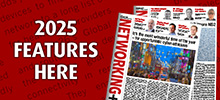12 December 2025

Stephen Patrick, CEO/founder, CableFree: Wireless Excellence
With the rollout of 5G accelerating across the country, IT teams face the challenge of ensuring seamless indoor coverage where outdoor signals often falter due to building materials like concrete and glass. Poor connectivity can lead to productivity losses, frustrated employees, and missed opportunities in sectors like healthcare, retail, and finance.
Find out moreMaximise uptime & efficiency with the perfect PDU
06 November 2025

Dami Munter, Marketing Manager, Schleifenbauer Products B.V
Power distribution is often overlooked when upgrading or expanding an IT network. Yet the right Power Distribution Unit (PDU) can make a big difference to reliability, visibility, energy efficiency and overall cost control across server rooms, network closets and hybrid infrastructures.
1. Match the PDU to your environment: Start with the basics: understand your network’s total power draw and outlet types. A PDU designed for continuous full-load operation and higher ambient temperatures will provide more headroom for future hardware.
Find out more
09 October 2025

Mark Yeeles, Vice President, Secure Power division, Schneider Electric UK & Ireland
The accelerated computing trend, and artificial intelligence (AI) in particular, has driven equipment and energy density in data centres like never before.
Power per rack has reached averages of 12kW in 2024, with 30kw not uncommon. AI systems have been observed drawing 130kW/rack, with certain development roadmaps expected to see 600kW per rack in 2027.
Practically speaking, even with close management such as hot aisle/cold aisle set ups, air cooling begins to lose efficiency and effectiveness from the 30kW per rack stage. That is why liquid cooling is being adopted so widely as it offers greater opportunities for efficient, targeted, and tightly controlled cooling.
Find out moreAI-ready data centres – preparing for the future
07 October 2025

Lauri Salmia, Applied Portfolio Manager, Trane
When it comes to preparing for AI-ready data centres, there is no one-size-fits-all cooling solution. The ongoing revolution in AI, machine learning, and high-performance computing is rapidly transforming data centre operations and demands, changing and placing unprecedented pressure on cooling infrastructure. The diversity of workloads, ranging from traditional storage and enterprise applications to exceptionally high-density AI/GPU compute environments, requires a flexible, scalable approach.
Find out moreWhy AI-ready UK data centres need to rethink their thermal strategy
03 October 2025

Bernie Malouin, JetCool Founder and Flex Vice President
Artificial intelligence (AI) is transforming every industry and putting unprecedented demands on the infrastructure that powers it. In the UK, data centre operators face a perfect storm of rising energy costs, tougher sustainability mandates, and the challenge of keeping legacy systems in step with next-generation hardware. Among all these pressures, a major challenge looms: cooling.
With major chipmakers and hyperscalers now talking about rack power densities that could reach 1 MW — and AI workloads driving 24/7 demand — it’s clear that traditional air cooling won’t be enough for what’s coming. The question for operators is no longer if they should modernise their cooling strategy — but how quickly they can prepare, and whether they’re choosing the right technologies to stay ahead of the curve.








.jpg?lu=248)


